Ijraset Journal For Research in Applied Science and Engineering Technology
- Home / Ijraset
- On This Page
- Abstract
- Introduction
- Conclusion
- References
- Copyright
IOT Based Solar Dryer and Irrigation System
Authors: Prof. Meena Ugale, Mr. Ankur Foujdar, Mr. Sushil Nikumbh, Mr. Suyash Joshi
DOI Link: https://doi.org/10.22214/ijraset.2022.41823
Certificate: View Certificate
Abstract
“Sun drying” is the earliest method of drying farm produce ever known to man and it involves simply laying the agricultural products out open in the sun. This has several disadvantages since the farm produce are laid in the open sky and there is greater risk of spoilage due to adverse climatic situations and insects. Solar dryer is a device which are used to dry substances, mostly food products. A solar dryer is of two types – direct and indirect. In this paper the main idea is to construct a hybrid solar dryer by using the excess heat generated around the solar panel. We have learnt from various researches that as the temperature rises, the panels generate less voltage and become less efficient in producing electricity. So, to overcome this problem we have proposed a system such that a solar dryer can be constructed by using the excessive hot air generated near the solar panels. This will also keep the solar panel cool and maintain the efficiency. The electricity generated from the solar panel will be used in drip irrigation. This system will help the farmers to irrigate their farm and dry their food products with the help of solar energy.
Introduction
I. INTRODUCTION
India sees approximately 300 clear and sunny days on an average in a year. Considering the ever-growing demand of electricity, solar energy is one of the best suited options for this crisis. In worldwide, where electricity is the main problem, farmers frequently don’t have the electricity. Especially in remote areas where the use of an alternative energy is desired. In that situation solar panels are often used for converting solar energy to electrical energy. These solar panels are used as an absorber to store the energy and that energy is used for driving the water pump. Solar Panels are usually tested at 25°C. As solar panels get very hot in direct sunlight, this reduces their efficiency by 0.3-0.4% for every degree rise in temperature above 25°C. Conversely the efficiency of the solar panel increases by the same percent with every degree fall in temperature below the 25°C. As during daytime, the temperatures are well above 25°C in India the solar panels lose their efficiency. So, to overcome this issue the hot air generated near the solar panels due to overheating can be used elsewhere such as a hybrid solar dryer. This system uses a solar panel that is used to charge the battery. The battery will provide the electricity to run a water pump, which will then be used for irrigation or to transfer water from a source to a reservoir. To increase the efficiency of the solar panels, the panel will be cooled from the back using an exhaust fan and it will direct this hot air towards the solar dryer using a PVC pipe. In this way, the solar panel can be kept cool, and its efficiency will be maintained. The solar dryer will be used to dry food products. With the help of the mobile application, the user will be able to monitor and control the operation of the solar dryer and the irrigation system in real time.
II. LITERATURE SURVEY
Paper 1: Real-time controlling and monitoring of Solar drying and Water pumping system using IoT
Publication Year : 2020
Author(s) : Mr. Vinayak H. Deokar and Dr. Rupa S. Bindu
Summary: The authors of paper [1] Mr. Vinayak H. Deokar and Dr. Rupa S. Bindu describe the working of the solar dryer and a water pumping system that is monitored and controlled remotely via a mobile app. It has monitoring and remote-control system for solar drying and water pump using Xbee and GSM module. Xbee wirelessly sends real-time system data from the sensor to the central server every 20 seconds. The central server collects and stores the data and sends it to the cloud via the GSM module. Real-time monitoring and control can also be performed on the client side via a custom mobile application.
Paper 2 : A Solar Dryer Technology
Publication Year : 2020
Author(s) : Rahul Girase, Vishwas Mahajan, Ankita Kotwal and Akash Ugale
Summary - The authors of paper [2] Rahul Girase, Vishwas Mahajan, Ankita Kotwal and Akash Ugale introduced solar dryer types such as direct convection, forced convection, and hybrid with subtypes. We will also discuss the other three types of solar dryers. Solar dryers are categorized by the type of circulation (natural circulation and forced circulation). The purpose of this article is to introduce some basic types of solar heat drying systems with structures that more accurately indicate the drying efficiency of agricultural products and foods.
Paper 3 : Experimental study of a solar dryer with different flow patterns of air in the drying chamber
Publication Year : 2018
Author(s) : Syed Mohammed Shamiq, P Sudhakar and M Cheralathan
Summary : The main purpose of Paper [3] is to study the airflow distribution in the dryer and how changes in flow rate or air distribution affect the drying rate of the product and family. I suggested a more appropriate method. This paper consists of a collector (solar energy), a drying chamber, and a fan. A test was conducted to evaluate the optimum drying method by comparing the conditions when air was supplied only to the floor and when air was distributed separately to each roller. We also investigated the drying efficiency, drying rate, initial and final moisture content of green beans under two conditions, and the temperature distribution of each tray under the two conditions.
Paper 4 : Agricultural water pumping system with auto tracking
Publication Year : 2018
Author(s) : C.M. Mohan Raj, S. Sureshkannan, A. Krishna, R. Manikandan and T. Mukeshkanan
Summary : In paper [4] the authors C.M. Mohan Raj, S. Sureshkannan, A. Krishna, R. Manikandan and T. Mukeshkanan describes how to use solar energy to power a water pump and the different ways to do it. They also explain how it can be done automatically. A solar powered water pump system is composed of two basic components. These are photovoltaic panels and pumps. The smallest element of a photovoltaic panel is a solar cell. Each solar cell has two or more layers of semiconductor material specially prepared to generate direct current (DC) current when exposed to light. This direct current is collected by the wiring in the control panel. It is then supplied to a DC pump that pumps water when the sun is shining, or stored in a battery for later use in the pump. The purpose of this article is to explain how solar water heating systems work and how they differ from other power sources.
Paper 5 : Design and Construction of Solar Dryer for Drying Agricultural Products
Publication Year : 2017
Author(s) : Prof. Pravin M Gupta, Amit S. Das, Ranjit C. Barai, Sagar C Pusadkar and Vishal G. Pawar
Summary : In paper [5] the authors Prof. Pravin M Gupta, Amit S. Das, Ranjit C. Barai, Sagar C Pusadkar and Vishal G. Pawar explain how to make solar dryers from cheap materials. doing. Why do they use materials? This article also describes the step-by-step structure of the dryer. Introducing the design and structure of solar dryers for drying agricultural products. The dryer consists of a solar collector (air heater) with a baffle and a solar drying chamber that includes a frame with four homogenized screen baskets. Theair taken in from the air intake is heated in the solar collector chamber, passes through the drying chamber, and is used for drying.
Paper 6 : Monitoring and automation of the water pumping and storage process applied to a water treatment plant
Publication Year : 2018
Author(s) : C. A. Calderon, Miguel Cueva, Nilvar Cuenca, Alexis Honores, Danny Guaman, David Jimenez, and Cristian Ramirez
Summary : In paper [6], the authors C. A. Calderon, Miguel Cueva, Nilvar Cuenca, Alexis Honores, Danny Guaman, David Jimenez, and Cristian Ramirez have explained that drinking water treatment plant (DWTP), mainly in the rural areas, the pumping operations are done manually. This can result in human error, and it can lead to waste of water (vital resource) and energy consumed by the pumping system, and shortages from the DWTP to users. To overcome this, they have designed a lowcost technological architecture for the automation of the water pumping system using electronic components which can be controlled through IoT.
Paper 7 : IoT based model for monitoring and controlling water distribution
Publication Year : 2019
Author(s) : J G Natvidad and T D Palaoag
Summary : In paper [7], the authors J G Natvidad and T D Palaoag analyze how urbanization has increased water demand for a comfortable life in the city.
Water is becoming one of the major issues in cities, especially water distribution, use and, more importantly, water quality. Therefore, the author sought to overcome these water supply related problems and implemented appropriate monitoring and control systems. They used various IoT sensors. Their goal was to design and develop cheap, reliable and efficient techniques for improving community water distribution.
III. METHODOLOGY
A. Block Diagram
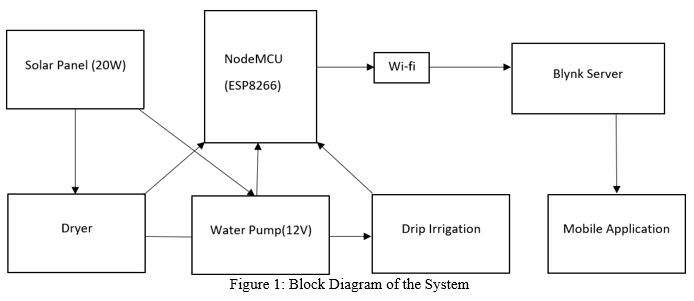
The block diagram gives an overview of the system. The solar panel is connected to the dryer and the pump. The pump is further connected to an irrigation system. The dryer, pump and irrigation system are connected to the microcontroller. It is routed to the Blynk server using the microcontroller's internal Wi-Fi module. The mobile application (Blynk IOT app) gets the data from the Blynk server.
B. System Architecture
The system architecture shows the connections made to the circuit. The solar panel is connected to the battery, which is further connected to the exhaust fan and water pump via a relay. Nodemcu is used to control the water pump and fan using the button controls in the Blynk app. The fan transfers the hot air below the solar panel to the solar dryer that houses the DHT11 sensor.
C. System Flow
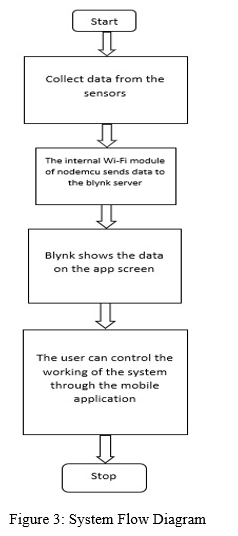
The figure above shows the flow from the start to the end of the system. The process begins by collecting data from the sensor, transferring the data to the Blynk server via the microcontroller's internal Wi-Fi module, displaying the data and controlling the system with a mobile application.
D. System Requirements
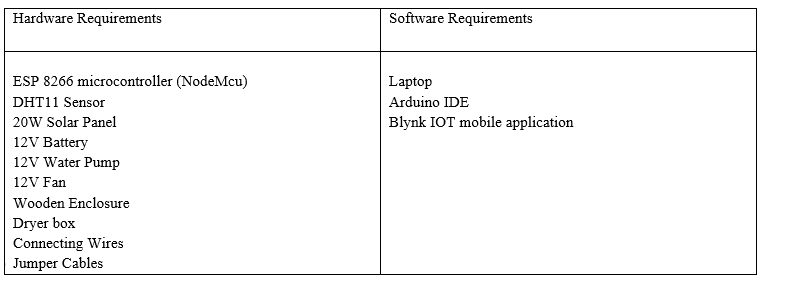
IV. .EXPERIMENTAL SETUP
In this experimental setup for a hybrid solar dryer, a 20 W solar panel is used to generate electricity. This power is stored in a 12V, 2.33A battery. The battery is used to power the 12V DC motor water pump. The DC 12V fan is also connected to the battery and the fan and water pump are connected to the battery via the relay module. The exhaust fan is used to cool the solar panel and push the hot air to the solar dryer through the pipe. Inside the dryer there is a DHT11 sensor to measure the temperature and humidity inside the dryer. The housing for the solar panel is a wooden box and the dryer is made of cardboard. The dryer is where the food will be dried.
The IOT platform is used to control and monitor the system. The Blynk IoT app is used to connect the ESP8266 (Nodemcu) microcontroller to the mobile app via the microcontroller’s internal Wi-Fi module. Data from the DHT11 sensor can be viewed in real time from the Blynk IoT app. The DC motor water pump and DC fan can be turned on or off from the button on the app.
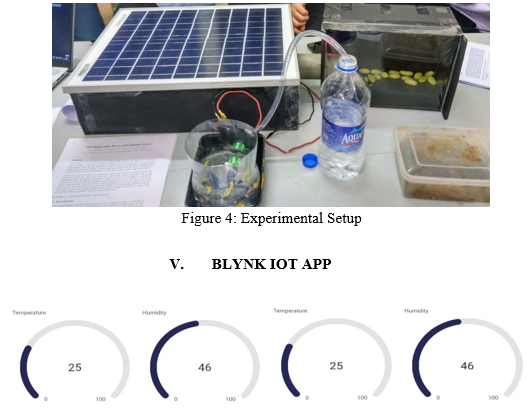
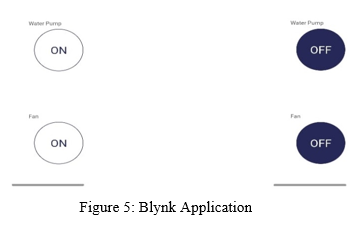
The figure above shows the mobile application interface. The Blynk IOT app is used for real time monitoring and controlling the system. The temperature and humidity values are displayed by the two gauges at the top and there are two buttons for the water pump and fan below the DHT11 sensor data.
VI. FUTURE SCOPE
- Addition of Cloud Services: The data collected by the sensors used in the system can be sent to cloud-based services such as Google Firebase.
- Addition of a Moisture Sensor: Moisture sensors can be added to the designed system to allow farmers to monitor soil moisture levels and operate water pumps accordingly.
- Automation of the Water Pump: The operation of the water pump and exhaust fan can be automated so that when the soil moisture drops, the pump will start pumping water into the field without the farmer having to start it himself via the button control of the app. When the temperature of the panel rises, the fan turns on automatically, and the operation of the exhaust fan can be automated so that the temperature of the panel drops.
Conclusion
Solar powered systems can lead to significant long-term cost savings and environmental footprint reductions compared to traditional power systems. In this article, the inefficiency of solar panels is overcome by using the extra heat generated by the panels in the solar dryer. This keeps the solar panels cool and maintains maximum efficiency. Solar dryers help dry crops and other foods. Real-time monitoring and control of the system can be performed via the Blynk IoT mobile application. This system can be used by farmers because the village does not have enough energy resources. It also provides farmers with an alternative to harmful fuels. The Pump can be used to transfer water from one source to another. Farmers can use this water for irrigation. This system can be used in industries that rely on solar energy to maintain the solar panels efficiency and use them for a longer period of time. The idea can even be expanded to businesses or industrial applications. Small scale businesses which rely on drying of fruits, spices, local food dishes etc can also use this system. Industries and housing societies having an array of solar panels can implement this system for longer life and to maintain efficiency of the panels.
References
[1] Mr. Vinayak H. Deokar and Dr. Rupa S. Bindu “Real-time controlling and monitoring of Solar drying and Water pumping system using IoT”, Mukt Shabd Journal, Volume IX Issue V, May 2020. [2] Rahul Girase, Vishwas Mahajan, Ankita Kotwal, and Akash Ugale “A Solar Dryer Technology”, IRJET, Volume 7 Issue 1, January 2020. [3] Syed Mohammed Shamiq, P Sudhakar and M Cheralathan “Experimental study of a solar dryer with different flow patterns of air in the drying chamber”, 2nd International conference on Advances in Mechanical Engineering, 2018. [4] C.M. Mohan Raj, S. Sureshkannan, A. Krishna, R. Manikandan and T. Mukeshkanan “Agricultural water pumping system with auto tracking”, IJERT, Volume 6 Issue 4, 2018. [5] Prof. Pravin M Gupta, Amit S. Das, Ranjit C. Barai, Sagar C Pusadkar and Vishal G. Pawar “Design and Construction of Solar Dryer for Drying Agricultural Products”, IRJET, Volume 04 Issue 03, March 2017. [6] C. A. Calderon et al., \"Monitoring and automation of the water pumping and storage process applied to a water treatment plant\", 13th Iberian Conference on Information Systems and Technologies (CISTI), 2018, pp. 1-6. [7] J G Natvidad and T D Palaoag “IoT based model for monitoring and controlling water distribution”, IOP Conf. Series: Materials Science and Engineering, 2019.
Copyright
Copyright © 2022 Prof. Meena Ugale, Mr. Ankur Foujdar, Mr. Sushil Nikumbh, Mr. Suyash Joshi. This is an open access article distributed under the Creative Commons Attribution License, which permits unrestricted use, distribution, and reproduction in any medium, provided the original work is properly cited.

Download Paper
Paper Id : IJRASET41823
Publish Date : 2022-04-25
ISSN : 2321-9653
Publisher Name : IJRASET
DOI Link : Click Here
 Submit Paper Online
Submit Paper Online


